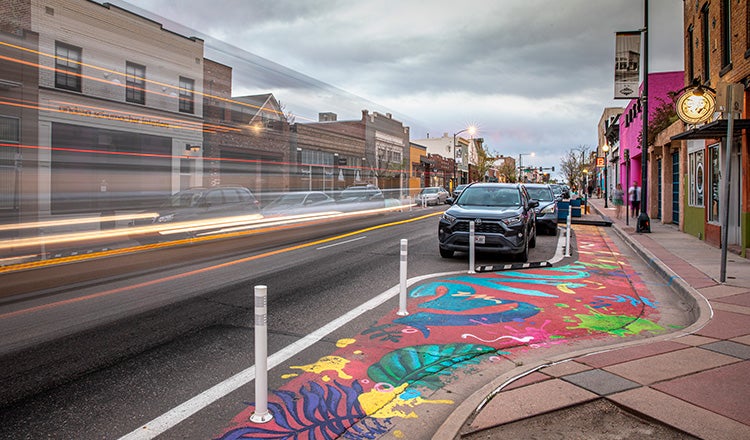Santa Fe Drive Streetscape Design

Santa Fe Drive Streetscape Design
Streetscape Design in Denver Art District Reinforces Community Building and Complete Streets Principles
Santa Fe Drive runs through the heart of Denver’s oldest art district, in a neighborhood rich in culture and creativity. The City and County of Denver, with support from the Santa Fe Business Improvement District, the Art District on Santa Fe and the La-Alma Lincoln Park Neighborhood Association, recognized the importance of improving the streetscape to move closer to the community’s long-term vision of a safe and comfortable experience for pedestrians. Despite the prominent role this corridor plays in the culture and urban fabric of Denver, the street is characterized by narrow sidewalks with limited opportunities for improvements along the one mile project length.
With the community at the heart of the design process, HDR worked closely with area residents, business owners and stakeholders to develop and design pilot streetscape improvements that encompass the community’s values and priorities for the corridor. Improvements will assist in stimulating the transformation of the corridor by rapidly reprogramming the street and reclaiming underutilized roadway space.
The resulting Complete Streets design reimagines Santa Fe Drive as a 21st century street that promotes diversity, inclusiveness and access, fosters public life, improves health and wellness in the public realm, provides comfortable sidewalks and safe intersections, mitigates and reduces noise and air pollution, and efficiently moves people, strengthening the local business community by giving patrons a reason to linger reflecting the eclectic spirit of the corridor. In addition, art installations by local artists enhance the identity, history and culture of Santa Fe.
Creating Accessible and Inclusive Public Spaces
HDR began by developing a summary analysis assessing how the existing public space is used along the corridor. This included determining the corridor and community identity, existing and future connections and destinations, ground floor façade quality and use, streetscape elements, plantings and health, and much more. The combined existing and future conditions analysis and collaboration with the community resulted in identifying design concepts that directly respond and adapt to the varying roles and demands required of the street.

The final design included the removal of one vehicular travel lane and repurposing that space for the pedestrians. This small, but mighty, change contributed an additional 40,000 square feet to the pedestrian realm for people of all ages and abilities. Small and large social spaces, including universally accessible benches, seating pods and parklets are spread along the corridor providing informal public seating and plantings to encourage people to stop and socialize. Additional streetscape elements, including planters, bike racks, asphalt art, improved lighting and seating at transit stops were also integrated into the design. Safe crossings thread the blocks together and rubber curbs are placed strategically to slow vehicular turns and define the vehicular and pedestrian realms throughout the pilot project limits.
Tapping Into the Community
Our team knew the importance this space held to various users and leveraged community input to help guide the design process. We worked closely with area residents, businesses, the city and local artists to develop a truly community-led design centered around the philosophy of placemaking, a people-centered approach to designing public space that prioritizes health, happiness and wellbeing. The HDR team connected with the community through a variety of mediums, including hosting three pop-up events in art galleries during The First Friday Art Walks and holding several design charrettes with both stakeholders and the Santa Fe Business Improvement District.
In addition, HDR showcased the preliminary design in August 2019 during the largest First Friday Art Walk of the year in order to engage and empower the community, test out early concepts and gain a better understanding of the specific corridor needs prior to final design and installation.







